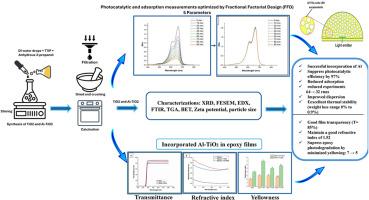Optimization and suppression of photocatalysis in Al-doped TiO2 particles using fractional factorial design to enhance optical performance in light-emitting diodes encapsulation
IF 4.2
3区 材料科学
Q2 MATERIALS SCIENCE, MULTIDISCIPLINARY
引用次数: 0
Abstract
This study tackles the challenge of high photocatalytic activity in TiO2, a limiting factor for its use as a filler in LED encapsulants, by doping it with aluminum. We used the Fractional Factorial Design to investigate the impact of five parameters on the photocatalytic and adsorption performance of Al-doped TiO2 particles. Characterization (XRD, SEM, EDX, FTIR, TGA, and nitrogen adsorption-desorption analysis) confirms the synthesis of mesoporous particles predominantly in the rutile phase, with traces of anatase. Successful Al incorporation yielded minimized agglomeration and enhanced thermal stability with a 0 %–0.9 % weight loss range. Our findings demonstrated that Al doping significantly reduced photocatalytic and adsorption performance, achieving a 97 % suppression of photocatalytic activity. Under optimized conditions, with an Al concentration of 0.51 g/L, calcination temperature of 900 °C, catalyst dosage of 1.5 g/L, MB solution temperature of 33.3 °C, and a pH of 4. The Al-doped TiO2 exhibited a photodegradation efficiency of 3 % and a rate constant of 0.0004 min−1, compared to 88 % PE and 0.02313 min−1 RC for pure TiO2. Calcination temperature significantly influences photocatalytic activity, while catalyst dosage and pH are key for adsorption. Epoxy films with Al-doped TiO2 particles showed higher transparency (85 %), a refractive index of 1.52, and the ASTM E313 Yellowness Index showed lower yellowing (YI 5) after UV exposure compared to TiO2 films (YI 7). The optical bandgap was found to be 3.45 eV for the pure epoxy film, slightly reduced to 3.39 eV with TiO2 incorporation, and restored to 3.45 eV with Al-doped TiO2, indicating that Al doping mitigates the bandgap reduction caused by TiO2. These results make Al-doped TiO2 particles promising for enhancing the application of TiO2 materials in light-emitting diode devices.

利用分数因子设计优化和抑制al掺杂TiO2颗粒的光催化作用以提高发光二极管封装的光学性能
本研究通过掺杂铝来解决TiO2高光催化活性的挑战,这是其作为LED封装剂填料使用的限制因素。我们使用分数析因设计来研究五个参数对掺杂al的TiO2粒子光催化和吸附性能的影响。表征(XRD, SEM, EDX, FTIR, TGA和氮吸附-脱附分析)证实了合成的介孔颗粒主要在金红石相,并伴有微量锐钛矿。Al的成功掺入使团聚最小化,热稳定性增强,重量损失范围为0% - 0.9%。我们的研究结果表明,Al掺杂显著降低了光催化和吸附性能,实现了97%的光催化活性抑制。在优化条件下,Al浓度为0.51 g/L,煅烧温度为900℃,催化剂用量为1.5 g/L, MB溶液温度为33.3℃,pH为4。al掺杂TiO2的光降解效率为3%,速率常数为0.0004 min−1,而纯TiO2的PE为88%,RC为0.02313 min−1。煅烧温度对光催化活性有显著影响,催化剂用量和pH是影响吸附的关键。与TiO2薄膜(YI 7)相比,al掺杂TiO2颗粒的环氧膜在紫外线照射后具有更高的透明度(85%),折射率为1.52,ASTM E313黄度指数(YI 5)更低。纯环氧膜的光学带隙为3.45 eV,掺杂TiO2后略微降低到3.39 eV,掺杂Al后恢复到3.45 eV,说明Al的掺杂减轻了TiO2引起的带隙降低。这些结果使得al掺杂TiO2粒子有望增强TiO2材料在发光二极管器件中的应用。
本文章由计算机程序翻译,如有差异,请以英文原文为准。
求助全文
约1分钟内获得全文
求助全文
来源期刊

Optical Materials
工程技术-材料科学:综合
CiteScore
6.60
自引率
12.80%
发文量
1265
审稿时长
38 days
期刊介绍:
Optical Materials has an open access mirror journal Optical Materials: X, sharing the same aims and scope, editorial team, submission system and rigorous peer review.
The purpose of Optical Materials is to provide a means of communication and technology transfer between researchers who are interested in materials for potential device applications. The journal publishes original papers and review articles on the design, synthesis, characterisation and applications of optical materials.
OPTICAL MATERIALS focuses on:
• Optical Properties of Material Systems;
• The Materials Aspects of Optical Phenomena;
• The Materials Aspects of Devices and Applications.
Authors can submit separate research elements describing their data to Data in Brief and methods to Methods X.
 求助内容:
求助内容: 应助结果提醒方式:
应助结果提醒方式:


